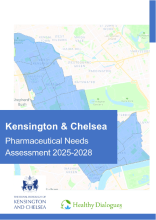Joint Strategic Needs Assessment
The Joint Strategic Needs Assessment (JSNA) identifies the current and future health and social care needs of the borough’s population and analyses whether needs are being met locally. It is carried out jointly by Kensington and Chelsea Council and NHS North West London for the NHS.
Visit the JSNA hub for more details.
Pharmaceutical Needs Assessment
The Government requires all Health and Wellbeing Boards to produce an assessment of pharmaceutical services in its area. The Pharmaceutical Needs Assessment (PNA) reports on the need for and provision of pharmacy services in a local area. It is used by NHS England to make decisions about applications to open new pharmacies or to change their location.
Thank you for feeding into our latest Pharmaceutical Needs Assessment.

